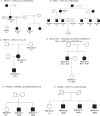Molecular Diagnosis of Inherited Retinal Diseases in Indigenous African Populations by Whole-Exome Sequencing
- PMID: 27898983
- PMCID: PMC5132076
- DOI: 10.1167/iovs.16-19785
Molecular Diagnosis of Inherited Retinal Diseases in Indigenous African Populations by Whole-Exome Sequencing
Abstract
Purpose: A majority of genes associated with inherited retinal diseases (IRDs) have been identified in patients of European origin. Indigenous African populations exhibit rich genomic diversity, and evaluation of reported genetic mutations has yielded low returns so far. Our goal was to perform whole-exome sequencing (WES) to examine variants in known IRD genes in underrepresented African cohorts.
Methods: Whole-exome sequencing was performed on 56 samples from 16 families with diverse IRD phenotypes that had remained undiagnosed after screening for known mutations using genotyping-based microarrays (Asper Ophthalmics). Variants in reported IRD genes were identified using WES and validated by Sanger sequencing. Custom TaqMan assays were used to screen for identified mutations in 193 unrelated indigenous Africans with IRDs.
Results: A total of 3494 variants were identified in 217 known IRD genes, leading to the identification of seven different mutations (including six novel) in six genes (RHO, PRPF3, PRPF31, ABCA4, CERKL, and PDE6B) in six distinct families. TaqMan screening in additional probands revealed identical homozygous CERKL and PDE6B variants in four more patients.
Conclusions: This is the first report of WES of patients with IRDs in indigenous African populations. Our study identified genetic defects in almost 40% of the families analyzed, significantly enhancing the molecular diagnosis of IRD in South Africa. Thus, WES of understudied cohorts seems to present an effective strategy for determining novel mutations in heterogeneous retinal diseases.
Figures


References
Publication types
MeSH terms
Substances
LinkOut - more resources
Full Text Sources
Other Literature Sources
Medical

